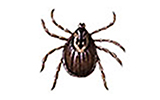
Characteristics
SIZE: About one-quarter of an inch in length.
COLOR: Dark reddish-brown.
BEHAVIOR: Like all ticks, the American dog tick is a bloodsucking ectoparasite. It is often referred to as a wood tick because it is found in wooded areas where mammalian hosts such as mice, squirrels, deer, raccoons and others live. It is also found near bodies of water where animals drink and are most active during the spring and summer.
Ticks require a blood meal at each stage of life in order to grow, and the female must engorge herself with blood to obtain the nourishment necessary to produce the thousands of eggs she lays, all in a single batch. Despite the large number of eggs produced, only a small percentage will make it to maturity. Ticks do not embed their entire head into a host, only the mouthparts. To keep the blood from clotting, the tick will inject an anti-clogging agent found in the saliva.
Bites from the American dog tick can sometimes cause a severe reaction. These ticks can transmit diseases such as Rocky Mountain Spotted Fever and Tularemia. Tick bite paralysis is another condition related to tick bites, but it rarely occurs in people.
Important Note: If you develop a spotty reddish rash on the hands, feet, arms and legs, suffer arthritis-like pain in one or more joints or have flu-like symptoms including severe headaches that come and go after recently being bitten by a tick, see your physician. Visit the Centers for Disease Control at www.cdc.gov for a full description of this disease.
Habitats
American dog ticks inhabit most states east of the Rocky Mountains and some parts of a few western states, such as California, Idaho and Washington. They frequent wooded areas and fields and are more common around homes and buildings in secluded or rural areas. This species is rarely found living indoors. If it is found inside, it will generally be discovered on dogs or cats.
Tips for Control
Ticks are difficult to control, therefore, the services of an experienced professional are recommended. Treatments may be necessary in areas of the yard where ticks are found. The best way to avoid tick bites is to stay away from tick-infested areas. However, if it is necessary, follow these tips when working or walking in areas potentially inhabited by ticks:
-
Wear long-sleeved shirts and long pants. Light colors are best so ticks are easier to detect.
-
Secure the bottom of pants inside socks or tie close around the ankles.
-
Wear a hat.
-
Tuck long hair under a hat.
-
Use tick repellent applied to clothing, particularly the lower body and the arms.
-
Carefully inspect your body after exiting infested areas. Have another person inspect your backside and back of your head.
-
Wash clothing in warm water and detergent immediately after leaving an area where tick-infestation is suspected.
-
Never throw potentially infested clothing in a hamper with other clothes or onto the floor.
-
Protect pets by preventing them from venturing into tick-infested areas or consult your veterinarian for tick treatment products. Remember, your dog can also contract many tick borne diseases.
-
Inspect pets carefully for ticks after walking them in wooded areas or fields.
-
To remove a tick embedded in your skin, do not grasp it by the abdomen and pull. You may squeeze its fluids into your skin, which increases the chances for infection. Use fine-tipped tweezers to grasp the tick by the head next to the skin and slowly pull backward. Working slowly permits the tick to withdraw its mouthparts so they do not detach and remain in the skin and become infected. Once the tick has been removed, cleanse the area well with soap and water. You may want to disinfect the bite site with alcohol or apply an antibiotic cream. Removal methods such as touching a hot object to the tick’s abdomen or putting petroleum jelly on the tick should not be used. These methods may cause the tick to release, but can cause disease organisms to enter your body when the tick is traumatized.
Looking for:
RESIDENTIAL SERVICES
COMMERCIAL SERVICES
